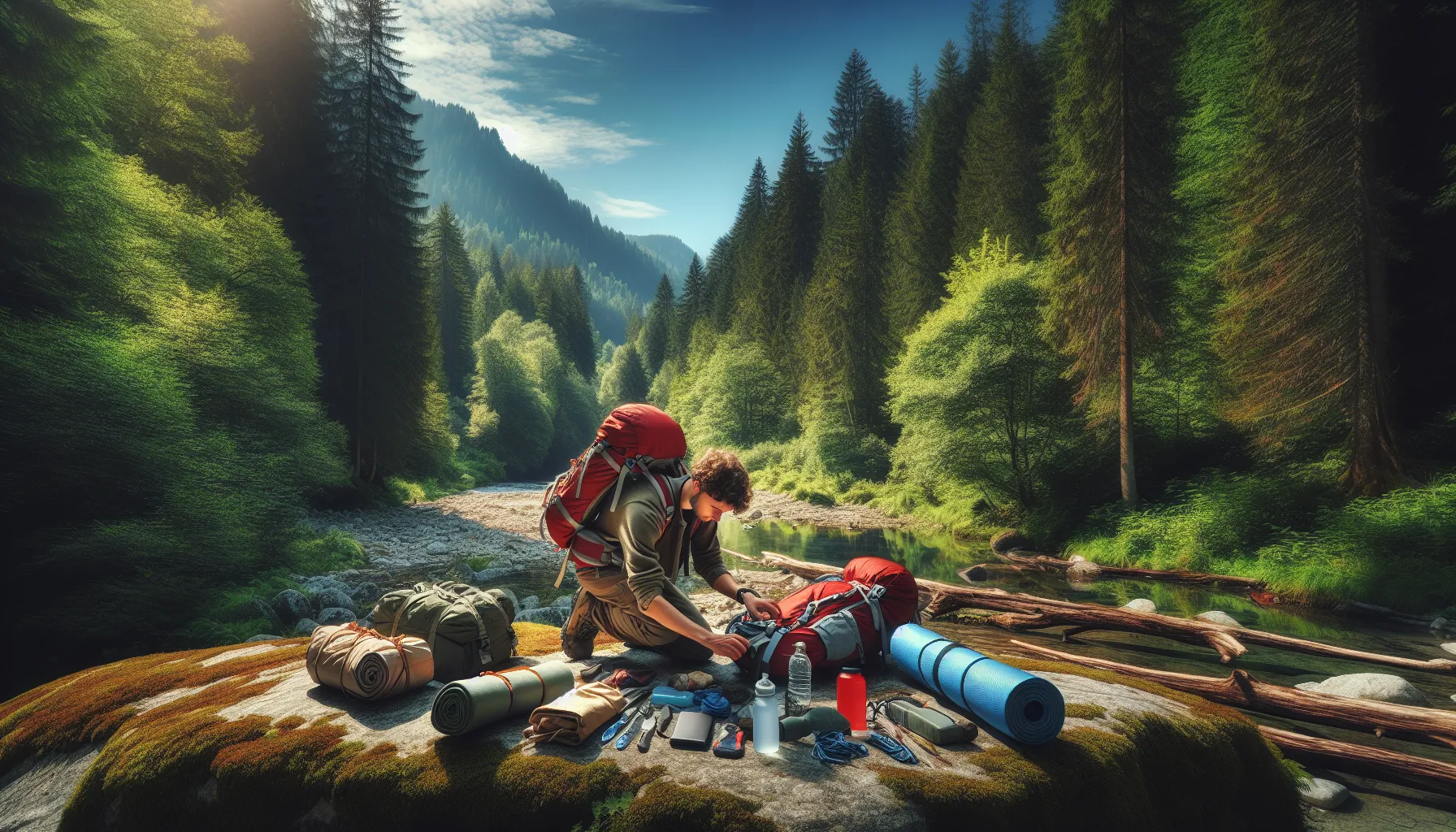Key Takeaways
- Properly packing a hiking backpack involves balancing weight, ensuring accessibility, and maintaining comfort to enhance your hiking experience.
- Select the right backpack size and features based on trip duration, load size, and your body type for maximum comfort.
- Follow weight distribution principles by placing heavy items near your back, medium-weight items in the center, and lighter items at the bottom or top.
- Create a detailed checklist of essentials tailored to trip conditions, focusing on necessities like water, food, layers, and emergency gear.
- Use tools like packing cubes or compression sacks to organize items efficiently and save space while ensuring weather protection.
- Avoid common mistakes such as overpacking, poor weight distribution, and ignoring trail-specific weather or terrain needs.
Packing a hiking backpack might seem simple, but trust me, it’s an art that can make or break your adventure. Overpacking can weigh you down while forgetting essentials can leave you unprepared. I’ve learned that a well-packed backpack isn’t just about fitting everything in—it’s about balance, accessibility, and comfort.
Understanding The Basics Of Packing A Hiking Backpack
Packing a hiking backpack involves more than just stuffing items in. It’s about knowing the essentials, arranging items for comfort, and maintaining a well-balanced load.
Choosing The Right Backpack
Selecting the right backpack depends on trip length, load size, and your body type. A day hike often requires a pack with a 20-30 liter capacity. Multi-day trips generally need 50-70 liters. Adjustable shoulder straps and a padded hip belt help distribute weight evenly. Look for packs with external pockets and hydration compatibility for added convenience.
Weight Distribution Principles
Organizing weight in your backpack ensures stability and reduces strain. Place heavier items, like a food stash or cooking gear, near your back and centered to avoid imbalance. Store mid-weight items, such as extra clothing, toward the middle of the pack. Light items, like a sleeping bag or outerwear, belong at the bottom and top. Distribute small essentials in external compartments for easy access.
Creating A Checklist Of Essentials
A checklist prevents forgotten items and overpacking. Include water, food, a first aid kit, navigation tools like a map or GPS, and layering clothes. Add a headlamp, multi-tool, sunscreen, and insect repellent. For overnight trips, pack a sleeping bag, tent, and cooking kit. Tailor the list to the season and trip requirements.
Step-By-Step Guide To Packing A Hiking Backpack

Packing a hiking backpack effectively ensures comfort, balance, and easy access during your hike. Follow these steps to create a well-organized and efficient load.
Packing Heavy Items
I place heavy items, like the tent body, food stash, or hydration reservoir, in the center of the backpack closest to my back. This positioning stabilizes the weight and improves balance. For a hydration reservoir, I insert it into the designated sleeve if my backpack offers one, ensuring it’s secured. Compressible items like food in bags or energy bars can be packed tightly to prevent shifting.
Organizing Medium-Weight Items
Medium-weight items such as cookware, extra clothing layers, and shoes go around or just above the heavy items. I ensure these items fill gaps and help keep the center of gravity low. For example, I roll clothes compactly to save space and position them strategically to pad breakable gear, like a camp stove or fuel canister.
Placing Lighter Items
I tuck lighter items, like my sleeping bag, sleeping pad, or down jacket, at the bottom of the pack. Lightweight but urgent items, like a first-aid kit or snacks, are placed near the top for quick access. Packing lighter items last helps distribute weight evenly and prevents back strain during long hikes.
Using Outer Pockets And Straps
I use the outer pockets and straps for easily reachable essentials. Water bottles, sunscreen, and a map go into exterior side or front pockets. Trekking poles, tent poles, or a foam sleeping pad are secured to the external straps. For wet or dirty gear, like rain jackets, I use mesh pockets for ventilation and separation from clean items. Properly utilizing external compartments maximizes the pack’s functionality.
Tips For Efficient Packing

Efficient packing ensures comfort and convenience during hikes. Proper organization and a balanced load make the journey more enjoyable.
Minimizing Unnecessary Items
Carrying only essential items reduces strain and creates more room for important gear. I stick to a checklist tailored for the trip’s duration, weather, and terrain. Multipurpose tools, like a Swiss army knife, save space by serving various functions. I avoid duplicate items (e.g., extra utensils) and leave non-essentials, like bulky gadgets or too many clothing options, behind.
Using Packing Cubes Or Stuff Sacks
Packing cubes and stuff sacks keep items organized and compact. I use color-coded or labeled cubes to separate clothing, toiletries, and gear, making it easier to find things. Compression sacks reduce the volume of bulky items like sleeping bags, freeing up space. Waterproof options ensure important items, like clothing, stay dry in unpredictable weather.
Balancing Comfort And Accessibility
Strategic item arrangement ensures the pack’s weight won’t cause discomfort and keeps frequently used gear within easy reach. I place essential items, such as snacks, a map, and a rain jacket, in top compartments or outer pockets. Less-needed items, like spare clothing or a sleeping pad, go deeper in the pack. Balancing heavy gear close to the spine minimizes strain during long hikes.
Common Mistakes To Avoid When Packing

Packing a hiking backpack requires careful thought, but common mistakes can lead to discomfort or problems on the trail. Avoid these errors to ensure a smoother hiking experience.
Overpacking Or Underpacking
Bringing too much gear or skipping essentials can create issues. Overpacking adds unnecessary weight, making the hike exhausting, while underpacking risks leaving out critical supplies, like extra layers or first-aid kits. I always stick to a checklist to bring only what I truly need. For instance, one multi-use tool could replace multiple single-function items, saving both space and weight.
Poor Weight Distribution
Unevenly packed gear affects balance and causes strain. Placing all heavy items, like food or cookware, in one area can destabilize the pack and increase the risk of injury. I distribute weight by keeping heavy items near the spine and medium-weight items close to them, while lightweight gear goes at the bottom and top. This arrangement keeps my load balanced and comfortable.
Ignoring Weather And Terrain Needs
Failing to pack for specific weather or terrain can leave anyone unprepared. Skipping rain gear on a wet trail or forgetting trekking poles on challenging terrain negatively impacts a hike. I always research the trail conditions beforehand, packing accordingly. For example, I include waterproof layers and durable footwear for muddy routes or insulated clothing for colder climates.
Conclusion
Packing a hiking backpack isn’t just about throwing gear together—it’s about creating a system that works for you. With the right approach, you can enjoy a more comfortable and stress-free adventure on the trail. Taking the time to plan, organize, and pack thoughtfully makes all the difference in how you experience your hike.
Remember, a well-packed backpack isn’t just practical—it’s empowering. When everything is in its place and your load feels balanced, you’re free to fully enjoy the journey ahead. Happy hiking!
Frequently Asked Questions
Why is it important to pack a hiking backpack properly?
Properly packing a hiking backpack ensures balance, comfort, and accessibility during your hike. It prevents strain on your back, avoids discomfort caused by overpacking, and ensures you have quick access to essential gear when needed.
How do I choose the right backpack for hiking?
Select a backpack based on your trip length, load size, and body type. Look for packs with appropriate capacity (measured in liters) and features such as padded straps, ventilation, and external compartments for convenience.
Where should heavier items be placed in a hiking backpack?
Heavier items, like food and a tent, should be stored close to your back and centered to maintain balance. This helps distribute weight evenly, preventing strain and improving stability.
What are some essential items to include in a hiking backpack?
Essentials typically include a first-aid kit, navigation tools, water, food, extra clothing, a tent or shelter, a sleeping bag, and weather-specific gear. Adjust the checklist based on trip length and conditions.
How can I optimize space when packing a backpack?
Use packing cubes, stuff sacks, and multipurpose tools to save space. Compress bulky items like sleeping bags and roll clothing tightly to maximize available room in your pack.
What are common mistakes to avoid when packing a hiking backpack?
Avoid overpacking or underpacking, which can cause discomfort or leave you unprepared. Don’t place all heavy items in one area, as it disrupts balance. Also, pack according to the weather and trail conditions.
How can I ensure quick access to essential items?
Strategically place urgent items, such as a first-aid kit, snacks, and a rain jacket, at the top or in accessible outer pockets. This minimizes the need to dig through your pack during the hike.
What are the benefits of using packing cubes or stuff sacks?
Packing cubes and stuff sacks keep your items organized and compact, making it easier to find what you need. Color-coded options can further speed up your packing and unpacking process.
Why is weight distribution important in a hiking backpack?
Proper weight distribution prevents strain on your back and shoulders, improves stability, and enhances overall comfort during the hike. It makes navigating uneven terrain safer and easier.
How can I ensure I don’t forget important gear for my hike?
Create a checklist of essentials before packing. Tailor the list to your hike’s duration, weather, and trail conditions to ensure you pack everything you need without overpacking unnecessary items.

